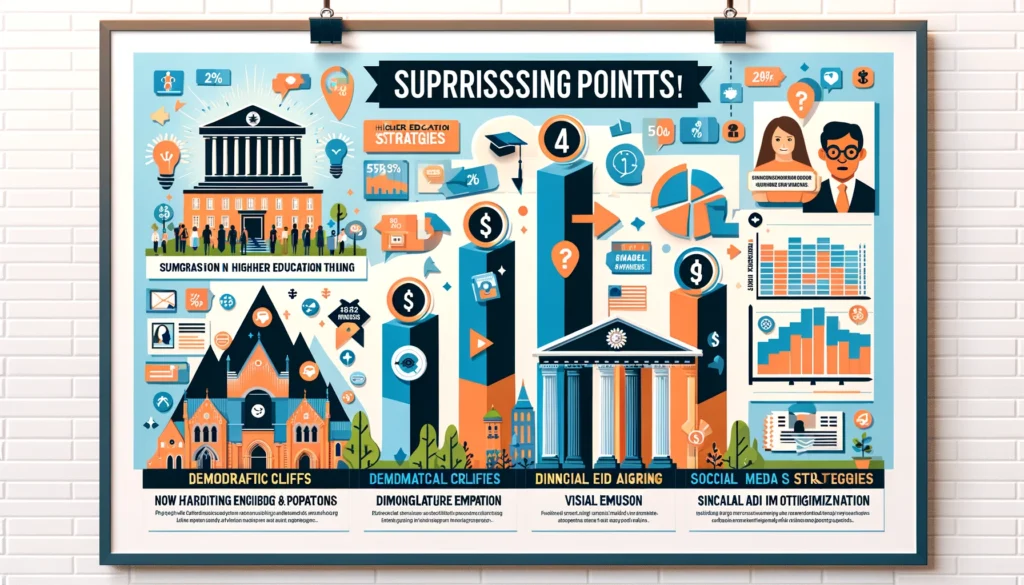Common Themes:
- Data-driven strategies: Emphasis on using data analytics, KPIs, and metrics to drive decisions and improvements (e.g., enrollment management, financial aid optimization, marketing).
- Personalization and engagement: Focus on targeting the right audience, personalizing content, and enhancing engagement through visuals and storytelling.
- Digital presence: Importance of optimizing online and mobile presence, leveraging digital marketing, and using platforms like LinkedIn and Facebook effectively.
- Continuous improvement: Need for ongoing optimization, experimentation, and refinement in various processes (e.g., marketing campaigns, blog workflows).
- Support and collaboration: Enhancing student support services and collaborating with external partners to improve outcomes and visibility.
Surprising Points:
- Demographic cliffs: The concept of two demographic cliffs impacting traditional and adult student enrollments, requiring diversification of revenue streams.
- Visual emphasis: The strong focus on the visual appeal and storytelling in LinkedIn ads as a key to engagement and success.
- Financial aid optimization: The detailed impact and benefits of using financial aid optimization software to attract and retain students.
- Specific social media strategies: Detailed reasons behind the lack of likes on school Facebook posts, including the importance of hashtags and responding to comments.

7 Reasons Your School Facebook Posts Aren’t Getting Likes
Higher Education Marketing
Synopsis:
- Author discusses the lack of likes on school Facebook posts and provides seven reasons for it.
- The seven reasons are:
- Poor timing of posts
- Not targeting the right audience
- Lack of engaging content
- Neglecting to include visuals
- Insufficient use of hashtags
- Failing to respond to comments or messages
- Inconsistent posting frequency
Background resources:
- None provided in the article.
Unique/noteworthy positions:
- The author emphasizes the importance of targeting the right audience and tailoring content to their preferences and interests.
- There is a focus on utilizing visual content, such as images and videos, to increase engagement on Facebook posts.
- The author suggests using relevant hashtags to make the posts discoverable by a wider audience.
Summary with takeaways:
- It is crucial to post content on Facebook at the right time to maximize visibility and engagement.
- Understanding your target audience and tailoring content to their preferences is key to garnering likes.
- Including engaging visuals, such as images and videos, can significantly increase engagement.
- Using relevant hashtags makes posts discoverable and helps reach a wider audience.
- Responding to comments and messages promptly contributes to building a positive online presence.
- Consistency in posting frequency is important to maintain audience engagement.
“Struggling to get likes on your school’s Facebook posts? 😕 Check out these 7 reasons and fix your social media game! 💪🎓 #FacebookTips #Engagement”
Tweet

Leveraging Digital Marketing Campaign Data to Drive Continuous Improvement
Ruffalo Noel Levitz
Synopsis:
In this article, the author explores the importance of leveraging data from digital marketing campaigns to drive continuous improvement in enrollment management. The article emphasizes the need for colleges and universities to utilize data analytics in order to make informed decisions and optimize their marketing efforts. The author highlights various strategies for effectively analyzing campaign data, such as tracking key performance indicators (KPIs), using data visualization tools, and conducting A/B testing. The article also discusses the role of marketing automation platforms in collecting and organizing campaign data. Additionally, the author emphasizes the significance of utilizing the insights gained from data analysis to make data-driven decisions to improve enrollment outcomes.
Background Resources:
- Data analytics
- Key performance indicators (KPIs)
- Data visualization tools
- A/B testing
- Marketing automation platforms
Noteworthy positions taken by the author:
- The author emphasizes the need for colleges and universities to embrace data analytics to enhance their enrollment management strategies.
- The article suggests that utilizing data from digital marketing campaigns can lead to continuous improvement in enrollment outcomes.
Summary and Takeaways:
- Utilizing data from digital marketing campaigns is crucial for continuous improvement in enrollment management.
- Tracking KPIs, using data visualization tools, and conducting A/B testing can help colleges and universities analyze campaign data effectively.
- Marketing automation platforms play a significant role in collecting and organizing campaign data.
- It is important to make data-driven decisions based on the insights gained from data analysis to improve enrollment outcomes.
“📊🎯 Data-driven campaigns boost enrollment! 📈 Use digital marketing data to improve continuously. #EnrollmentManagement #DigitalMarketing”
Tweet
Financial Aid Optimization: A Behind the Scenes Look | Carnegie—A Higher Ed Marketing and Enrollment Agency
Carnegie—A Higher Ed Marketing and Enrollment Agency
https://www.carnegiehighered.com/blog/financial-aid-optimization-product-feature
Synopsis
- Financial aid optimization is a crucial tool for higher education institutions to attract and retain students.
- This blog post discusses the benefits of using financial aid optimization software and its impact on student enrollment and retention.
- The author highlights the key features and functionality of financial aid optimization software, such as data analytics and modeling techniques.
- Case studies are provided to demonstrate the success of financial aid optimization in colleges and universities.
- The author suggests that by leveraging financial aid optimization tools, institutions can make informed decisions and allocate financial aid resources effectively.
Background Resources
- No background resources are cited in the article.
Noteworthy Positions
- The author emphasizes the role of financial aid optimization in student enrollment and retention strategies, positioning it as a powerful tool for higher education institutions.
- Case studies are used to support the effectiveness of financial aid optimization software in real-world scenarios.
Summary and Takeaways
- Financial aid optimization software is instrumental in attracting and retaining students in higher education institutions.
- By utilizing tools like data analytics and modeling techniques, institutions can make informed decisions about allocating financial aid resources.
- Through case studies, the article showcases the positive impact of financial aid optimization on enrollment and retention rates.
- Financial aid optimization software can help reduce administrative burden and enhance the overall student experience.
“💰🎓 Need help allocating financial aid? Check out this article on financial aid optimization in higher ed! 💪 #HigherEd #FinancialAid #DataAnalytics”
Tweet
Using LinkedIn Ads Strategically for Higher Education – Part I
Terminalfour Higher Education Digital Marketing Blog
Synopsis
- The article discusses the strategic use of LinkedIn ads in the higher education sector.
- It explores the benefits of LinkedIn as a platform for targeting the right audience for higher education institutions.
- The author provides insights into various ad formats and targeting options available on LinkedIn.
- The article offers tips on setting campaign objectives, creating compelling ads, and tracking performance.
- Several case studies are included to illustrate successful LinkedIn ad campaigns by higher education institutions.
- The author highlights the importance of continuous optimization and experimentation in LinkedIn ad campaigns.
Background Resources
- No background resources are cited in the article.
Noteworthy Positions
- The author emphasizes the targeting capabilities and audience relevance of LinkedIn for higher education institutions.
- The importance of tracking and analyzing campaign performance is stressed to ensure effective ad campaigns on LinkedIn.
Summary and Takeaways
- LinkedIn ads can be a valuable tool for higher education institutions to connect with their target audience.
- Targeting options on LinkedIn can help reach specific demographics, job titles, and industries relevant to the institution’s programs.
- Ad format choices include Sponsored Content, Text Ads, and Dynamic Ads, each with its own strengths and use cases.
- Setting clear campaign objectives, creating compelling ad copy and visuals, and monitoring performance are essential for success.
- Case studies demonstrate how institutions have successfully utilized LinkedIn ads.
- Continuous optimization and experimentation are key to maximizing the effectiveness of LinkedIn ad campaigns.
“🎓💼 Reach the right students with precision targeting. Learn to create compelling LinkedIn ads for higher ed success. #LinkedInAds #HigherEducation”
Tweet

20 Great Examples Of Higher Ed Ads On Linkedin- Part II
terminalfour.com
https://www.terminalfour.com/blog/posts/20-great-examples-of-higher-ed-ads-on-linkedin-part-ii.html
Synopsis:
- The article showcases 20 excellent examples of higher education advertisements on LinkedIn, focusing on their effectiveness and creative elements.
- Each of the ads is analyzed and described in detail, highlighting their objective, target audience, content, and unique aspects.
- The selection of ads includes various formats such as videos, carousels, and single images, allowing for diverse marketing strategies.
- Noteworthy positions taken by the author include emphasizing the importance of visual appeal, storytelling, and clear call-to-actions in advertisements.
Background Resources:
- No specific background resources are referenced in the article.
Unique/Noteworthy Positions:
- Visual appeal: The author underscores the significance of eye-catching visuals in capturing the audience’s attention and conveying the message effectively.
- Storytelling: Utilizing storytelling techniques in ads can create a connection with the target audience and make the content more memorable.
- Clear call-to-actions: The author emphasizes the need for explicit and straightforward instructions that direct viewers on what to do next after seeing the ad.
Summary with Takeaways:
- The article presents 20 outstanding examples of higher education ads on LinkedIn, illustrating their effectiveness in attracting and engaging LinkedIn users.
- The ads cover a multitude of formats, demonstrating the versatility and creativity in higher education marketing strategies.
- Key takeaways include the importance of visually appealing ads, incorporating storytelling elements, and providing clear call-to-actions for optimum impact.
“🎓 Discover 20 brilliant 🌟 higher ed LinkedIn ads! Captivating visuals and compelling stories to inspire. #HigherEdMarketing #LinkedInAds 💼✨”
Tweet

Adapting to Landscape Changes in Student Search | Carnegie—A Higher Ed Marketing and Enrollment Agency
Carnegie—A Higher Ed Marketing and Enrollment Agency
https://www.carnegiehighered.com/blog/adapting-to-changes-in-student-search
Synopsis:
- The article discusses the importance of higher education institutions adapting to changes in student search behavior.
- It highlights the shift from traditional search methods to digital platforms, such as search engines and social media.
- It emphasizes the need for institutions to optimize their online presence and engage with students through various digital channels.
- The article suggests utilizing data analytics and personalized marketing strategies to better target and attract prospective students.
- It also addresses the role of mobile devices in student search behavior and the significance of having a mobile-friendly website.
- The author mentions the challenges faced by institutions in keeping up with rapid technological advancements and changing student preferences.
- The article provides insights into successful strategies employed by some institutions to adapt to the evolving student search landscape.
Background resources:
- The article refers to data and surveys conducted by various organizations, such as Inside Higher Ed, The National Student Clearinghouse Research Center, and the Education Market Association.
- It also mentions the importance of leveraging digital tools like Google Analytics and social listening platforms for understanding student search behaviors.
Noteworthy positions:
- The author emphasizes the need for higher education institutions to prioritize digital marketing efforts and invest in their online presence.
- They advocate for the use of data-driven strategies, personalized communications, and mobile optimization to effectively engage with prospective students.
- The article underlines the importance of staying informed about evolving student search trends and adapting marketing approaches accordingly.
Summary and takeaways:
- Higher education institutions must adapt to changing student search behavior and prioritize digital marketing efforts.
- Optimizing online presence, engaging through digital channels, and personalizing communications are key strategies.
- Data analytics and mobile optimization are crucial for understanding and catering to student preferences.
- Staying informed about evolving trends is vital to effective marketing.
- Successful strategies include utilizing data, employing personalized marketing approaches, and having a mobile-friendly website.
“Adapt to changing student behavior with personalization, data analytics, and mobile optimization. #DigitalMarketing 📊📲”
Tweet
4 Steps to Build a Blog Writing Workflow | Carnegie—A Higher Ed Marketing and Enrollment Agency
Carnegie—A Higher Ed Marketing and Enrollment Agency
https://www.carnegiehighered.com/blog/how-to-make-your-blog-workflow-work-for-you
Synopsis:
- The article discusses strategies to effectively manage and optimize the workflow for a blog.
- It emphasizes the importance of implementing a structured workflow to enhance productivity and efficiency.
- The author suggests steps for setting up an efficient blog workflow, including planning, creating an editorial calendar, and collaborating with team members.
- Various tools and resources are proposed to streamline the blogging process, such as content management systems, project management software, and editorial workflows.
- The author also emphasizes the significance of tracking and analyzing metrics to measure the effectiveness of the blog workflow.
- Noteworthy positions taken by the author include the importance of seeking feedback, refining processes, and continuously improving the blog workflow.
Background resources:
- The article references the book “The Content Code” by Mark Schaefer, highlighting the relevance of a strategic content marketing framework.
Takeaways:
- Implementing a structured workflow is essential to optimize productivity and efficiency in blogging.
- Key steps in setting up an effective blog workflow include planning, creating an editorial calendar, and collaborating with team members.
- Utilize tools such as content management systems, project management software, and editorial workflows to streamline the blogging process.
- Tracking and analyzing metrics are crucial to measuring the success and effectiveness of the blog workflow.
- Seek feedback, refine processes, and continually improve the blog workflow to maximize results.
“⌨️ Boost blogging productivity with an optimized workflow! Learn to plan, collaborate, and track metrics. 📝✅ #BloggingTips #WorkflowOptimization”
Tweet
